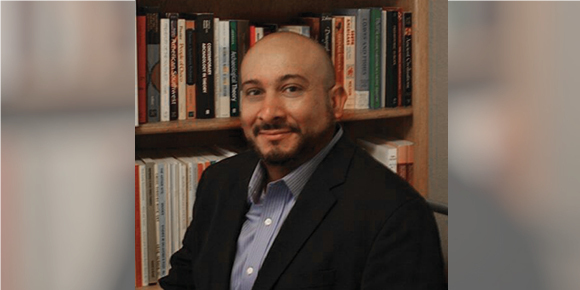Our Collective Past: New Director Emphasizes Lived Experiences

Dr. Taylor-Montoya
Growing up in his native Albuquerque, John Taylor-Montoya enlisted the willing support of his two sisters to conduct, in his words, “archaeological digs” in the backyard of the family’s North Valley home. His childhood fascination with the prospect of unearthing the unknown would eventually lead him to a distinguished career in public archaeology, including his recent appointment as executive director of the Office of Archaeological Studies (OAS).
In addition to digging holes in his backyard, he describes as "deep enough to do double-duty as childhood forts,” Taylor-Montoya had a passion for drawing. One day, while browsing the shelves in the La Luz Elementary School library, a book cover with King Tut's iconic gold mask caught his gaze. Even more enticing was the book’s title—Art and Archaeology—perfectly pairing his love for artistic expression with his curiosity about the past.
Taylor-Montoya's parents actively nurtured his budding interests, gifting him books on history and archaeology for birthdays and holidays. This complemented family vacations to such favorite New Mexico sites as the ruins at Salinas Pueblo Missions National Monument, Coronado Historic Site's Kuaua Pueblo, and Jemez Historic Site's Gíusewa Pueblo and San José de los Jémez mission. These formative experiences further ignited his passion for the field, setting him on a path to undergraduate and graduate degrees in anthropology.
Taylor-Montoya spent 20 years working in the private sector “throughout the greater Southwest, at sites that run the full range of resources, from Ice Age Paleoindian sites to Puebloan sites, to Cold War-era military facilities and historic buildings.” There, he developed the diverse background needed to lead the OAS, a complex organization with varied programs and stakeholders—including groups of enthusiastic individuals who volunteer at the Center for New Mexico Archaeology and participate in such educational programs as the Friends of Archaeology.
Taylor-Montoya, who worked briefly as an OAS program director before taking the helm, was attracted to this new position because of the division’s strong educational focus, which he says will allow him to be “more directly involved in people’s lives in New Mexico, to be more among the gente.” Wearing the dual hats of historian and archaeologist, Taylor-Montoya asserts that 21st-century archaeology in New Mexico should enhance our understanding of the state’s diverse historical legacies. “Our stories—those of the Native Americans, Hispanos, and those who’ve more
lately come to this state—they don't just reside in history books, they resonate through the lived experiences of our families today, enriching our understanding of our collective past," he says.
Drawing from his own graduate experience, where comparative collections at other institutions enriched his university studies, Taylor-Montoya envisions utilizing OAS’s unique collections and data to similarly enhance the education of today’s university students. He also sees OAS leveraging its resources with other divisions within the New Mexico Department of Cultural Affairs, such as New Mexico Historic Sites. By actively pursuing these collaborations, he says, OAS can sustain and grow its already well-deserved reputation as a vibrant hub for learning, research and community engagement.
The results of OAS’s vital scientific inquiries should “flow seamlessly from our laboratories to OAS's award-winning outreach programs, engaging our publics—from curious elementary schoolers to enthusiastic laypeople,” he says. To that end, Taylor-Montoya seeks to further broaden OAS audiences through social media, as well as through educational and interpretive materials distributed at outreach events.
As an institution with a statewide mandate, Taylor-Montoya understands that OAS programs require private funding through the Museum of New Mexico Foundation for program preparation and delivery, supplies and travel. He says that more active statewide marketing of OAS, in addition to the greater visibility that social media provides, will “raise public awareness and promote understanding and support for archaeology's ability to contribute to our communities.” This, in turn, will “facilitate support from potential new [donor] prospects.”
This article and image are from the Museum of New Mexico Foundation’s Member News Magazine.


Connect